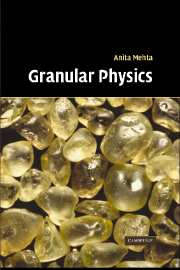Book contents
- Frontmatter
- Contents
- Preface
- 1 Introduction
- 2 Computer simulation approaches – an overview
- 3 Structure of vibrated powders – numerical results
- 4 Collective structures in sand – the phenomenon of bridging
- 5 On angles of repose: bistability and collapse
- 6 Compaction of disordered grains in the jamming limit: sand on random graphs
- 7 Shaking a box of sand I – a simple lattice model
- 8 Shaking a box of sand II – at the jamming limit, when shape matters!
- 9 Avalanches with reorganising grains
- 10 From earthquakes to sandpiles – stick–slip motion
- 11 Coupled continuum equations: the dynamics of sandpile surfaces
- 12 Theory of rapid granular flows
- 13 The thermodynamics of granular materials
- 14 Static properties of granular materials
- References
- Index
- Plate section
14 - Static properties of granular materials
Published online by Cambridge University Press: 06 October 2009
- Frontmatter
- Contents
- Preface
- 1 Introduction
- 2 Computer simulation approaches – an overview
- 3 Structure of vibrated powders – numerical results
- 4 Collective structures in sand – the phenomenon of bridging
- 5 On angles of repose: bistability and collapse
- 6 Compaction of disordered grains in the jamming limit: sand on random graphs
- 7 Shaking a box of sand I – a simple lattice model
- 8 Shaking a box of sand II – at the jamming limit, when shape matters!
- 9 Avalanches with reorganising grains
- 10 From earthquakes to sandpiles – stick–slip motion
- 11 Coupled continuum equations: the dynamics of sandpile surfaces
- 12 Theory of rapid granular flows
- 13 The thermodynamics of granular materials
- 14 Static properties of granular materials
- References
- Index
- Plate section
Summary
In this chapter, we are interested in static pilings of cohesionless grains. For example, we would like to be able to describe how forces or stresses are distributed in these systems. As a matter of fact, this is not a simple issue as, for instance, two apparently identical sandpiles but prepared in different ways can show rather contrasted bottom pressure profiles.
The aim is to be as complementary as possible to the existing books on granular media. There are indeed numerous ones which deal with Janssen's model for silos, Mohr–Coulomb yield criterion or elasto-plasticity of granular media or soils, see e.g. We shall then sum up only the basics of that part of the literature and spend more time with a review of the more recent experiments, simulations and modellings performed and developed in the last decade. This chapter is divided into two main sections. The first one is devoted to microscopic results, concerning in particular the statistical distribution of contact forces and orientations, while, in the second part, more macroscopic aspects are treated with stress profile measures and distribution. Finally, let us remark that, although the number of papers related to this field is very large, we have tried to cite a restricted number of articles, excluding in particular references written in another language than English, as well as conference proceedings or reviews difficult to access.
Statics at the grain scale
Static solutions
Equilibrium conditions
Let us consider a single grain in a granular piling at rest.
- Type
- Chapter
- Information
- Granular Physics , pp. 233 - 273Publisher: Cambridge University PressPrint publication year: 2007



